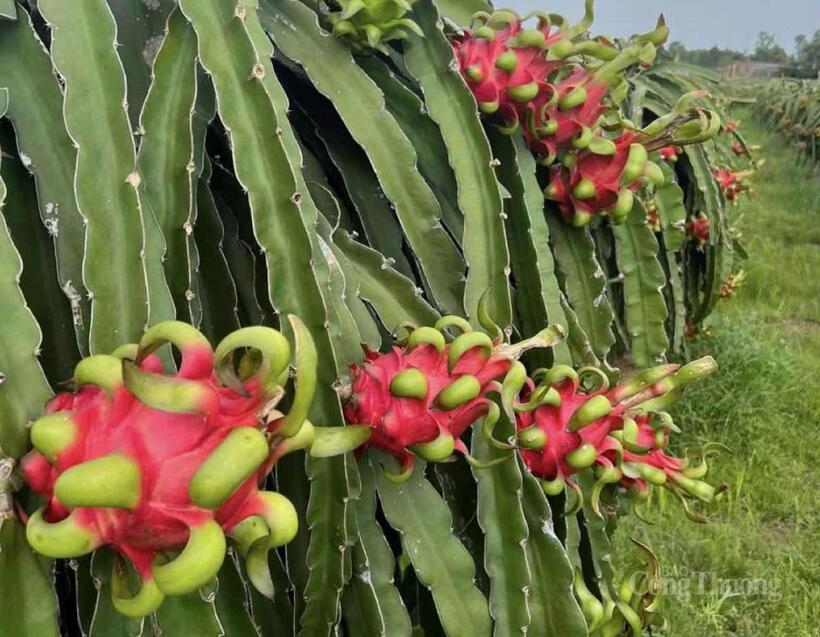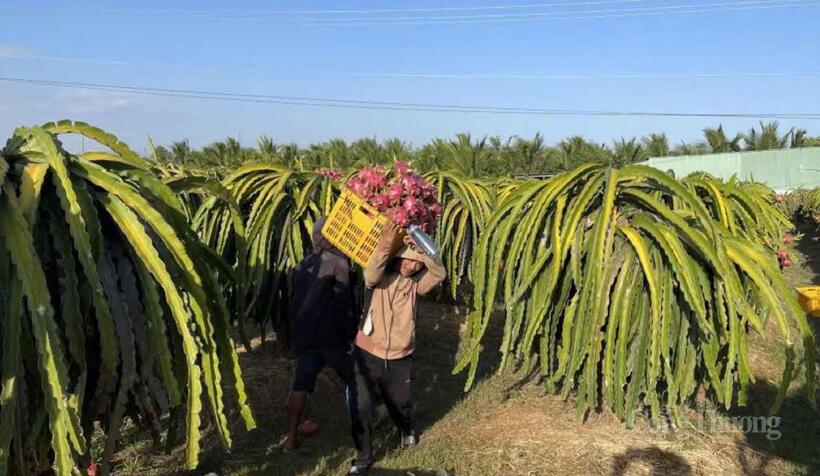
Vietnam to review over 20 years of Resolution 36 on overseas Vietnamese
19:05 | 23/03/2025 16:32 | 23/12/2025News and Events
Building market linkages to boost sales
Dragon fruit has long been a key agricultural product of Binh Thuan Province, with nearly 30,000 hectares under cultivation, accounting for more than 60 percent of the nation’s total. In recent years, the province has expanded dragon fruit cultivation in not only coastal plains, but also mountainous communes such as La Da, Ham Can, Ham Thanh, and Thuan Quy, home to many ethnic minority communities.

Photo: Duy Tan
Transitioning from the planting of traditional crops like cashews and upland rice or small-scale livestock breeding, ethnic groups such as the Raglai, K’ho, and Cham have increasingly embraced dragon fruit as a high-value crop. Many households have adopted VietGAP and GlobalGAP standards, learned to use off-season lighting and efficient irrigation systems, and are gradually becoming familiar with product traceability through QR codes.
The expansion of dragon fruit cultivation into mountainous areas has not only increased the province’s overall growing area but also created sustainable livelihoods for hundreds of ethnic minority households. However, the biggest challenge is no longer technical but market access. Unstable prices, reliance on middlemen, and a lack of strong market linkages continue to hinder progress.
To address these issues, local agricultural cooperatives are playing a growing role in organizing production and facilitating market access for upland communities.
The Hoa Le Clean Dragon Fruit Cooperative in Ham Liem Commune, Ham Thuan Bac District stands out as a model. With over 200 hectares under cooperative agreements and annual sales reaching 6,000 tonnes, the cooperative provides a stable market for dozens of Raglai households. Beyond fresh fruit, it also produces processed items such as dried dragon fruit, jams, and fruit wine, and has developed its own brand for e-commerce platforms.
In the same commune, the Thuan Tien Dragon Fruit Cooperative is partnering with more than 50 ethnic minority households to cultivate dragon fruit under VietGAP standards. Through a closed-loop value chain, from cultivation to sales, the cooperative has signed sales contracts with major distributors in Ho Chi Minh City and Hanoi, ensuring stable prices even during off-peak seasons.
These modern cooperative models not only bring farmers together but also help them gradually enhance production capacity, adopt new technologies, standardize products, and, most importantly, learn how to engage professionally with the market.
Looking toward sustainable marketing, leaving no one behind
To develop such models, support from local authorities is critical. In recent years, the Binh Thuan Provincial Department of Industry and Trade has shifted its focus from administrative management to market creation and trade promotion strategy.

Photo: Duy Tan
Dragon fruit development is now integrated across national trade promotion programs, rural industry development plans, and the province’s digital transformation roadmap for agriculture.
Under the department’s guidance, units such as the Binh Thuan Center for Industry and Trade Promotion have taken the lead in building value chain-based trade promotion models, ranging from training, brand development, and market connections to digital commerce.
In early 2025, the center established a dedicated team to manage and operate Binh Thuan Province’s e-commerce platform. Designed not only as a product showcase but as an active trade channel, the platform enables producers to connect directly with modern consumers without intermediaries. Integrated features include product traceability, delivery, and quality reviews, building consumer trust and expanding market reach.
According to Mr. Dang Trung Thai, Director of the Binh Thuan Center for Industry and Trade Promotion, the province will also continue to organize trade fairs, Vietnamese goods markets in remote areas, and both in-province and out-of-province exhibitions to connect fresh and processed dragon fruit products with consumers across regions.
“We don’t just help farmers grow dragon fruit, we want to help them understand and participate in the market proactively. Trade promotion must align with each cooperative’s capacity to access markets. No one should be left behind,” Mr. Dang Trung Thai emphasized.
Supporting ethnic minority communities in marketing dragon fruit must go beyond short-term, seasonal efforts. It should be a long-term strategic direction for the development of mountainous and ethnic minority regions. The key is to build a well-functioning ecosystem that links production, commerce, and consumption, where local people are not just growers but product owners.
Only when dragon fruit is recognized not merely as produce but as a regional specialty imbued with identity, can policies truly deliver tangible outcomes. Achieving this requires strong coordination between the government, businesses, cooperatives, the media, and the wider consumer community.
Once a symbol of agricultural innovation in Binh Thuan Province, dragon fruit was celebrated not just by farmers, but by an entire coastal region known for its deep cultural roots. Today, this familiar fruit carries a new mission: serving as a catalyst for ethnic minority communities to take charge of their livelihoods, with skill, initiative, and a market-oriented mindset.
In upland areas like La Da, Ham Can, and Ham Thanh, Raglai, Cham, and K’ho farmers are no longer just growing dragon fruit. They follow production standards, join cooperatives, implement traceability systems, livestream sales, and professionally package their goods. Step by step, they are earning their place in the competitive farm produce market. But to move beyond scattered successes, they need a stronger, more targeted trade promotion strategy rooted in the unique context of ethnic minority regions.
It is not enough to produce well if the product struggles to reach the market. Highland dragon fruit must go further, into supermarkets, onto e-commerce platforms, tied to eco-tourism, and developed as a local brand with geographical indication and cultural identity. Only then can these communities truly take ownership of their products in today’s modern economy, not as recipients of charity, but as market players in their own right.
To preserve dragon fruit is to preserve local economic resilience. More importantly, it is about ensuring ethnic minorities hold a meaningful, empowered role in the agricultural value chain, not standing on the sidelines, but leading their own way forward.

19:05 | 23/03/2025 16:32 | 23/12/2025News and Events

19:05 | 23/03/2025 16:30 | 23/12/2025Trade

19:05 | 23/03/2025 23:26 | 22/12/2025Industry

19:05 | 23/03/2025 23:19 | 22/12/2025News and Events

19:05 | 23/03/2025 14:41 | 22/12/2025News and Events